The bold and the beautiful
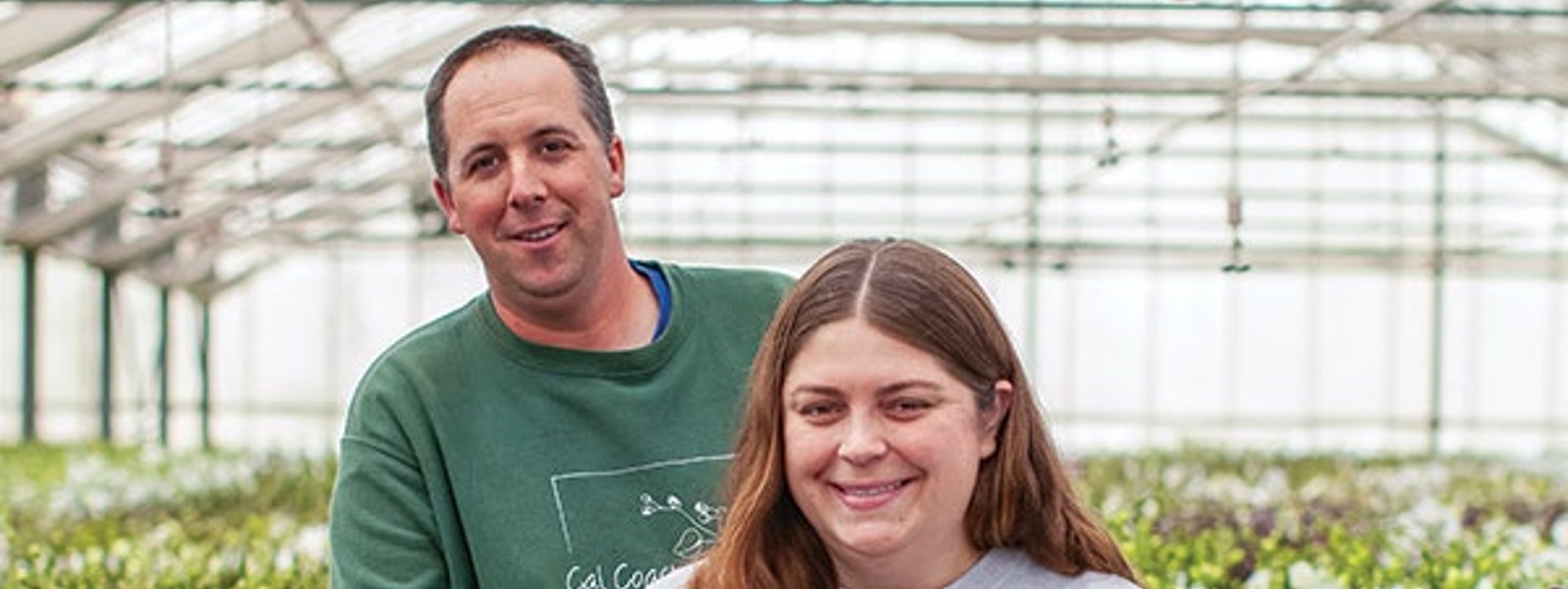
Summer 2024 California Bountiful magazine
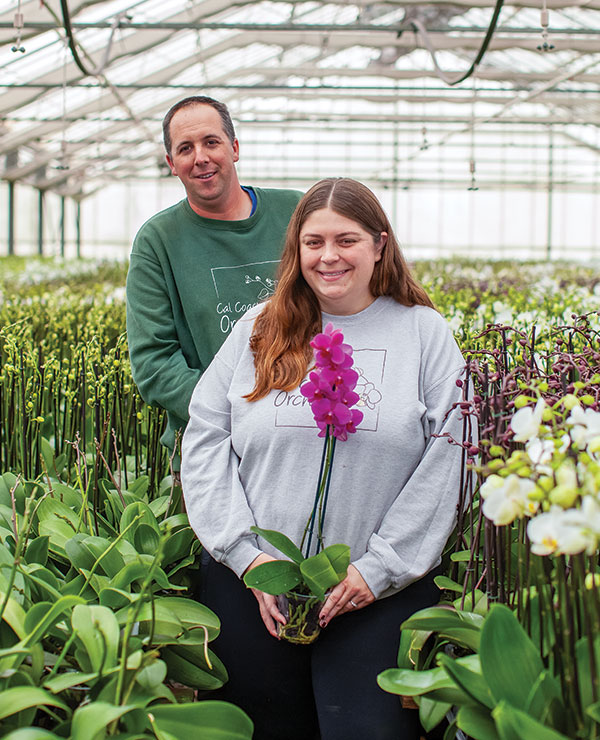
Couple pursues ‘crazy dream’ to grow orchids
Story by Caitlin Fillmore
Photos by Applemoon Photography
With their showy blooms and tall, elegant stems, orchids serve as a brilliant centerpiece and well-received gift for any occasion. But shoppers often question buying such a seemingly fussy plant, says Alison Glasco, who co-owns an orchid nursery with her husband. However, this exotic flower holds a rugged secret.
“There’s a big stigma about orchids being tricky to care for. But they’re actually really easy,” Glasco says. “The more you ignore the orchid, the more it will produce for you.”
Glasco fell in love with the enigmatic plant after first falling for Bas van Eijk, a newly arrived Dutch flower farmer with generations of cucumber growers and cattle ranchers in his family.
While Glasco had not planned on entering agriculture—she’d graduated with a degree in engineering physics—farming is what motivated van Eijk to relocate to the United States in 2013 after operating successful orchid farms in New Zealand. They discussed opening a greenhouse together on their first date, even though Glasco had never stepped inside one.
“I was just in awe of this Dutch guy,” she recalls. “It’s quite a little bit crazy, but here we are doing this crazy dream together.”

Getting started
Six years ago, van Eijk scrolled through Google Maps looking for available greenhouses in California. These satellite images eventually revealed an abandoned structure along the Central Coast in Los Osos, and showing the same gumption that drove him from the Netherlands to New Zealand looking for orchid employment, he left a Post-it note for the owner of the greenhouse. By that summer, Glasco and van Eijk moved in and Cal Coast Orchids was launched.
For the next two years, the pair focused on growing a wide array of Phalaenopsis orchids, nurturing each of more than 80 varieties through their final 20 weeks of maturity.
Cal Coast Orchids imports its smaller, more compact, European style of Phalaenopsis orchids from Canada, where the plants grow for the first 80 weeks in bark, instead of the more familiar moss. Orchids found in most supermarket chains are larger and grown in moss, as most countries cannot export bark to the U.S. However, bark provides a superior potting material for orchids, Glasco says.
“In nature, orchids grow out of bark, not sitting in a compacted moss bale,” she explains. “(With bark), the plant has a longer shelf life and better chance of reblooming because it’s being taken care of correctly and has a healthy root structure.”
While Glasco and van Eijk looked to the orchid’s natural habitat to influence the potting medium, the environment chosen for the greenhouse itself is anything but wild. Van Eijk manages a sophisticated array of technologies he calls the “cockpit of the greenhouse” to provide the ideal, eco-friendly surroundings for their orchids to thrive.
Cal Coast Orchids uses technology to set up tools like smart irrigation and sensitive climate controls to improve efficiency and reduce waste. A high-pressure misting system establishes an ideal humidity level without using sprinklers and fans. Automated, energy-saving curtains reduce the greenhouse’s energy usage by 70%, according to Cal Coast Orchids’ website.
Van Eijk spends a couple of hours every day checking the different graphs produced by his sustainability systems. “Climate is extremely important for orchids,” he says. “But from day one, we wanted to make sure we conserve nature.”
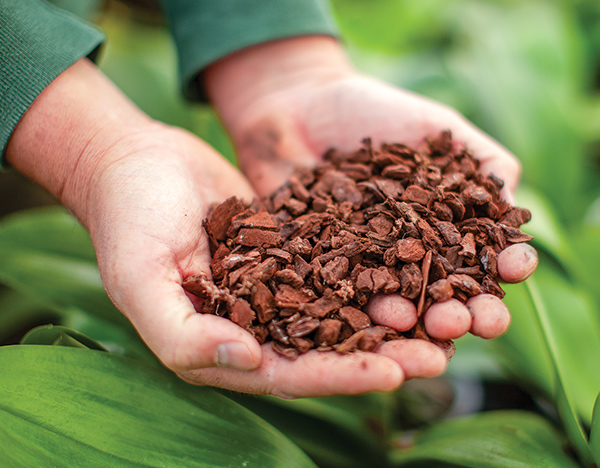
Continuing to expand
After six months of setting up systems and tending to orchids in the Los Osos greenhouse, van Eijk and Glasco readied for their first year of sales. As 75% of their orchids sell during the spring, the couple prepared for a successful season in spring 2020. Then the COVID-19 pandemic hit.
“We were ready to go and all of our customers came to us and said, ‘We are canceling orders,’” Glasco remembers. But the duo’s belief in their product, and the joy orchids bring, kept them focused on their ambitious plans as the pandemic spread.
“When a lot of people chose to halt production, we kept going,” Glasco says. “We thought people would want to buy something for their house to cheer it up.”
Their instincts proved right: Three weeks before Mother’s Day, one of the greenhouse’s busiest days of the year, their customers came back. “They said, ‘We’ll take everything you have!’” Glasco says. “And that freight train never stopped.”
As shoppers sheltered in place, they chose to feather their nests with flowers from Cal Coast Orchids, which began selling houseplants to keep up with the demand for plant therapy. Now the greenhouse sells nearly 600 varieties of houseplants. “We hadn’t planned on producing (houseplants). We were going to be strictly orchids,” Glasco says. “Now we offer a full one-stop shop of houseplants, succulents—everything from a 2-inch plant to an 8-foot tree.”
The frenzy of the pandemic ultimately boosted business for Glasco and van Eijk, who opened a second greenhouse in Half Moon Bay. Both locations combine for a total of 7 acres of greenhouse space, producing 3 million orchids per year. Cal Coast Orchids fulfills wholesale orders, delivers to independent garden centers and sells to individuals online, loading a trailer with orders daily.
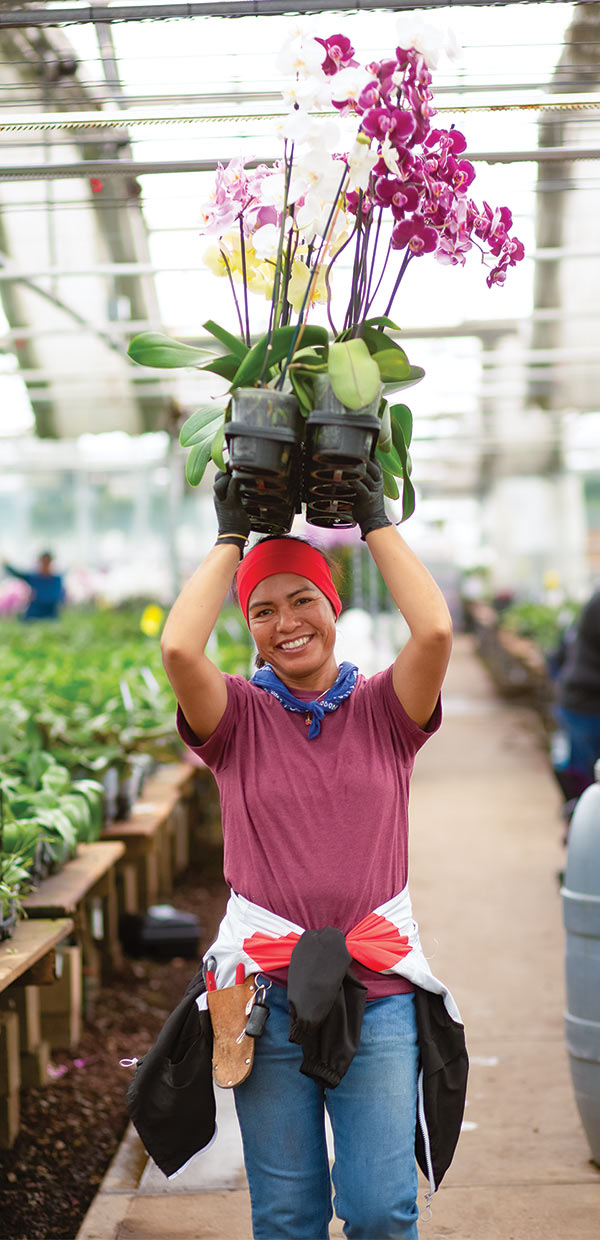
Raising the stakes
After six challenging years in business, Cal Coast Orchids shows no sign of slowing down. Today the greenhouse sells 100,000 orchids every Valentine’s Day and triple that amount at the Mother’s Day peak.
But van Eijk “doesn’t like boring” when it comes to agriculture—which led him to his next goal of reviving the scarce Cymbidium variety of orchid. The Cymbidium produces a slender, oval-shaped petal, stacking several large blooms on a thin stem. This variety also has thinner, grassier leaves than the Phalaenopsis orchid and comes in deep colors and striking variegations.
California was the “Cymbidium capital of the world” in the 1980s, van Eijk says, but the variety has since become a high-end collector’s item. The flower takes three and a half years to reach full maturity, driving up its price.
Cal Coast Orchids plans to debut its first crop of cool-weather-loving Cymbidium orchids in the fall of 2025. The co-owners are taking a risk on this specialized variety of orchid, already securing a third greenhouse in Carpinteria and planting the flowers that will be sold in 2029.
“It takes a lot of patience and making sure the customer has patience as well,” van Eijk says. “I’m excited to reintroduce the crop to the masses and make them more readily available for consumers across the country.”
Sometimes neglect is the secret to orchid care
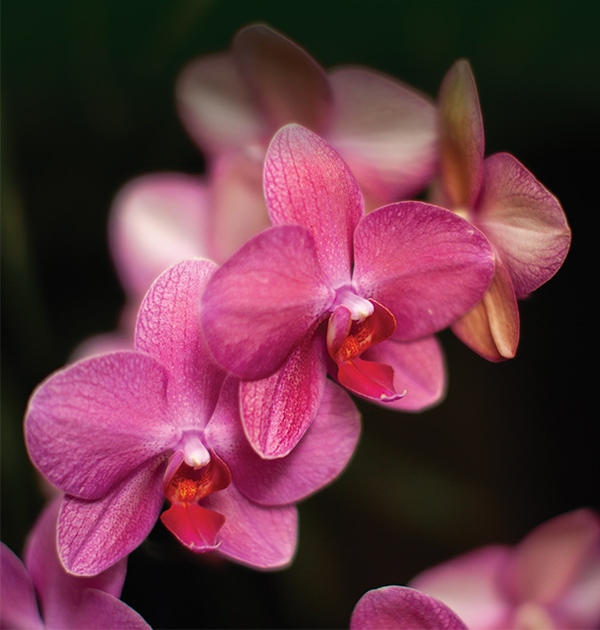
Orchid care can be pretty basic once an orchid parent has a better understanding of the plant, says Bas van Eijk, co-owner of Cal Coast Orchids.
Watering an orchid presents the first hurdle, as people tend to “over-baby” the plant with too much moisture. The secret lies in reading the roots, van Eijk says. Cal Coast Orchids chooses to plant its orchids in translucent pots to help buyers clearly see the roots and more easily identify when the flower needs water.
Once all the roots of the orchid plant appear a silvery-gray, the orchid needs water. But if the roots are still green? They’re still full of water, van Eijk says. “If you can’t tell? Wait another day,” he says.
Orchids grow as a hardy plant, capable of reblooming if there’s enough patience, van Eijk says. “It can take 20 to 30 weeks in a household to get a flower spike to rebloom,” he says. “It’s definitely a patience game.”
First trim the orchid spike, or the stem with flowers on it, to the second node (the bump on the stem). The correct trim provides two opportunities for reblooming: one potential flower that grows from the established stem and a slow-growing rebloom that begins from the base of the orchid.
If you’re having trouble reblooming the orchid, the problem is usually a doting plant parent. Try neglecting the plant to encourage more flowers, van Eijk says.
“When a plant starts to die, it will shoot out flowers (to encourage reproduction),” he says. Stress the plant by taking it out of its happy place to a location with a lower temperature, light level and humidity, like a dark corner or a bathroom. In five to seven weeks, new spikes will start to form and the orchid can be moved back to its preferred space.

